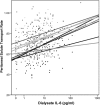Independent effects of systemic and peritoneal inflammation on peritoneal dialysis survival
- PMID: 24009237
- PMCID: PMC3839554
- DOI: 10.1681/ASN.2013030314
Independent effects of systemic and peritoneal inflammation on peritoneal dialysis survival
Abstract
Systemic inflammation, as evidenced by elevated inflammatory cytokines, is a feature of advanced renal failure and predicts worse survival. Dialysate IL-6 concentrations associate with variability in peritoneal small solute transport rate (PSTR), which has also been linked to patient survival. Here, we determined the link between systemic and intraperitoneal inflammation with regards to peritoneal membrane function and patient survival as part of the Global Fluid Study, a multinational, multicenter, prospective, combined incident and prevalent cohort study (n=959 patients) with up to 8 years of follow-up. Data collected included patient demographic characteristics, comorbidity, modality, dialysis prescription, and peritoneal membrane function. Dialysate and plasma cytokines were measured by electrochemiluminescence. A total of 426 survival endpoints occurred in 559 incident and 358 prevalent patients from 10 centers in Korea, Canada, and the United Kingdom. On patient entry to the study, systemic and intraperitoneal cytokine networks were dissociated, with evidence of local cytokine production within the peritoneum. After adjustment for multiple covariates, systemic inflammation was associated with age and comorbidity and independently predicted patient survival in both incident and prevalent cohorts. In contrast, intraperitoneal inflammation was the most important determinant of PSTR but did not affect survival. In prevalent patients, the relationship between local inflammation and membrane function persisted but did not account for an increased mortality associated with faster PSTR. These data suggest that systemic and local intraperitoneal inflammation reflect distinct processes and consequences in patients treated with peritoneal dialysis, so their prevention may require different therapeutic approaches; the significance of intraperitoneal inflammation requires further elucidation.
Figures


Comment in
-
Dialysis: Systemic IL-6 levels predict survival after peritoneal dialysis.Nat Rev Nephrol. 2013 Dec;9(12):708-10. doi: 10.1038/nrneph.2013.231. Epub 2013 Oct 29. Nat Rev Nephrol. 2013. PMID: 24166144
Similar articles
-
Dialysate cell-free mitochondrial DNA fragments as a marker of intraperitoneal inflammation and peritoneal solute transport rate in peritoneal dialysis.BMC Nephrol. 2019 Apr 11;20(1):128. doi: 10.1186/s12882-019-1284-3. BMC Nephrol. 2019. PMID: 30975091 Free PMC article.
-
Systemic and intraperitoneal interleukin-6 system during the first year of peritoneal dialysis.Perit Dial Int. 2006 Jan-Feb;26(1):53-63. Perit Dial Int. 2006. PMID: 16538876
-
Dialysis: Systemic IL-6 levels predict survival after peritoneal dialysis.Nat Rev Nephrol. 2013 Dec;9(12):708-10. doi: 10.1038/nrneph.2013.231. Epub 2013 Oct 29. Nat Rev Nephrol. 2013. PMID: 24166144
-
Peritoneal solute transport and inflammation.Am J Kidney Dis. 2014 Dec;64(6):978-86. doi: 10.1053/j.ajkd.2014.06.030. Epub 2014 Aug 29. Am J Kidney Dis. 2014. PMID: 25176170 Review.
-
Mitigating peritoneal membrane characteristics in modern peritoneal dialysis therapy.Kidney Int Suppl. 2006 Nov;(103):S76-83. doi: 10.1038/sj.ki.5001920. Kidney Int Suppl. 2006. PMID: 17080116 Review.
Cited by
-
Preventing Peritoneal Dialysis-Associated Fibrosis by Therapeutic Blunting of Peritoneal Toll-Like Receptor Activity.Front Physiol. 2018 Nov 27;9:1692. doi: 10.3389/fphys.2018.01692. eCollection 2018. Front Physiol. 2018. PMID: 30538643 Free PMC article. Review.
-
The body mass index change is associated with death or hemodialysis transfer in Japanese patients initiating peritoneal dialysis.Ren Fail. 2023 Dec;45(1):2163904. doi: 10.1080/0886022X.2022.2163904. Ren Fail. 2023. PMID: 36637000 Free PMC article.
-
Dialysate cell-free mitochondrial DNA fragments as a marker of intraperitoneal inflammation and peritoneal solute transport rate in peritoneal dialysis.BMC Nephrol. 2019 Apr 11;20(1):128. doi: 10.1186/s12882-019-1284-3. BMC Nephrol. 2019. PMID: 30975091 Free PMC article.
-
Dialysate interleukin-6 predicts increasing peritoneal solute transport rate in incident peritoneal dialysis patients.BMC Nephrol. 2014 Jan 10;15:8. doi: 10.1186/1471-2369-15-8. BMC Nephrol. 2014. PMID: 24410736 Free PMC article. Clinical Trial.
-
Ultrafiltration Failure Is a Reflection of Peritoneal Alterations in Patients Treated With Peritoneal Dialysis.Front Physiol. 2018 Dec 20;9:1815. doi: 10.3389/fphys.2018.01815. eCollection 2018. Front Physiol. 2018. PMID: 30618825 Free PMC article. Review.
References
-
- Brimble KS, Walker M, Margetts PJ, Kundhal KK, Rabbat CG: Meta-analysis: Peritoneal membrane transport, mortality, and technique failure in peritoneal dialysis. J Am Soc Nephrol 17: 2591–2598, 2006 - PubMed
-
- Asghar RB, Davies SJ: Pathways of fluid transport and reabsorption across the peritoneal membrane. Kidney Int 73: 1048–1053, 2008 - PubMed
-
- Chung SH, Heimbürger O, Stenvinkel P, Qureshi AR, Lindholm B: Association between residual renal function, inflammation and patient survival in new peritoneal dialysis patients. Nephrol Dial Transplant 18: 590–597, 2003 - PubMed
-
- Davies SJ, Phillips L, Naish PF, Russell GI: Quantifying comorbidity in peritoneal dialysis patients and its relationship to other predictors of survival. Nephrol Dial Transplant 17: 1085–1092, 2002 - PubMed
-
- Davies SJ, Bryan J, Phillips L, Russell GI: Longitudinal changes in peritoneal kinetics: The effects of peritoneal dialysis and peritonitis. Nephrol Dial Transplant 11: 498–506, 1996 - PubMed
Publication types
MeSH terms
Substances
LinkOut - more resources
Full Text Sources
Other Literature Sources
Medical

